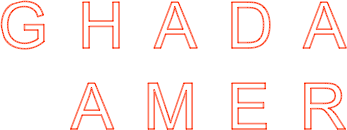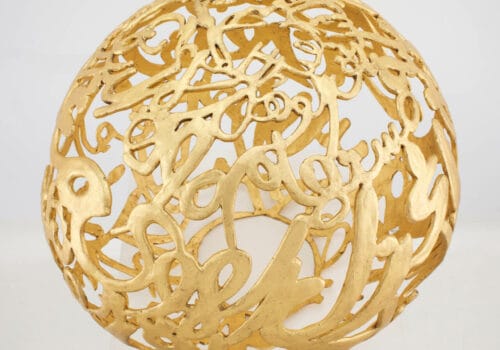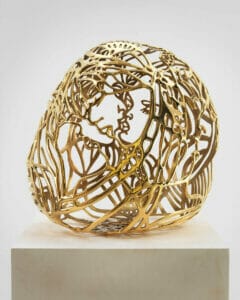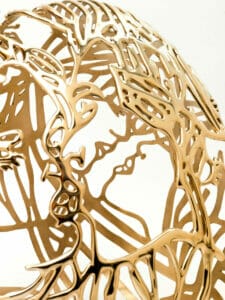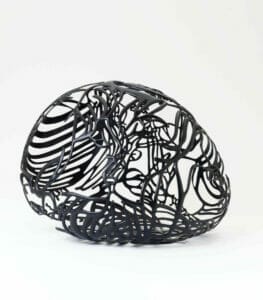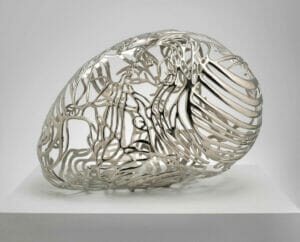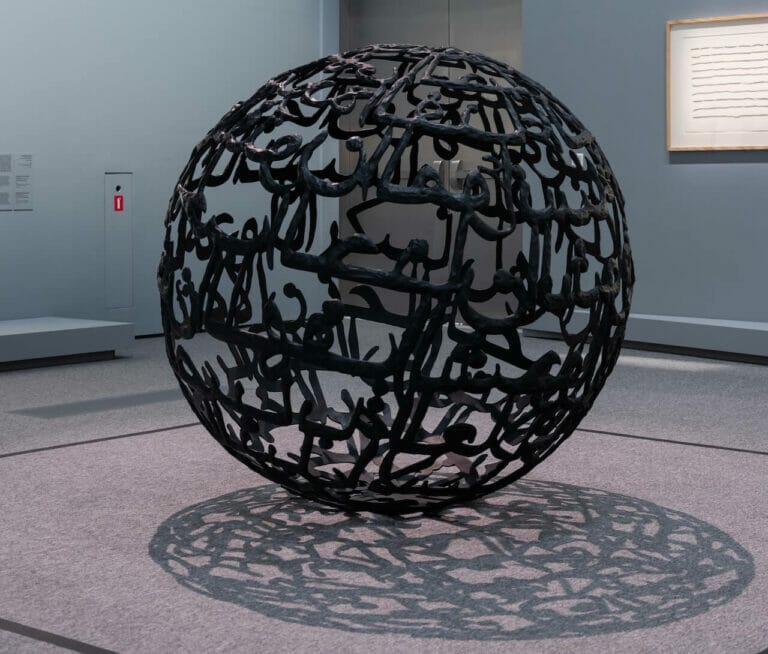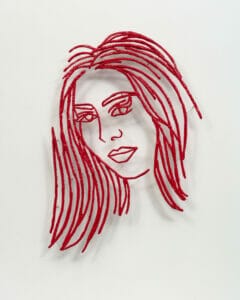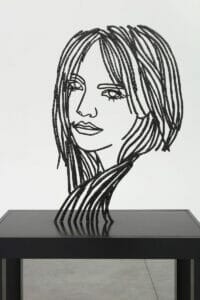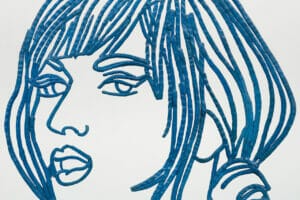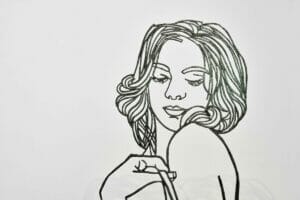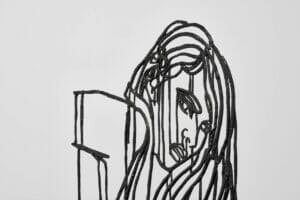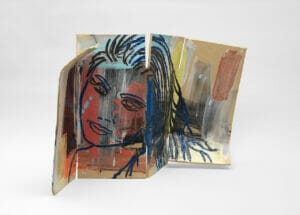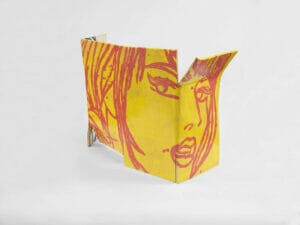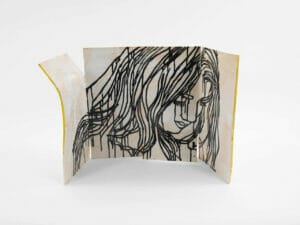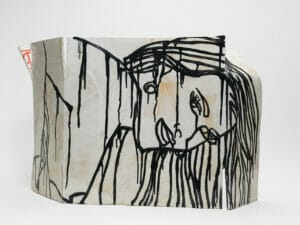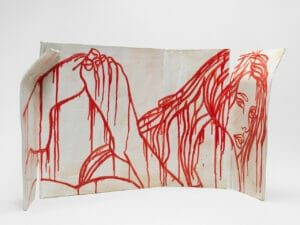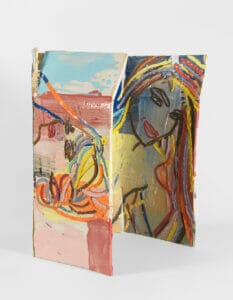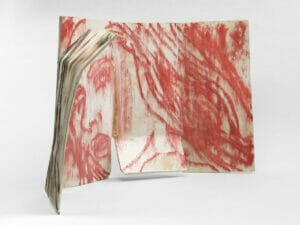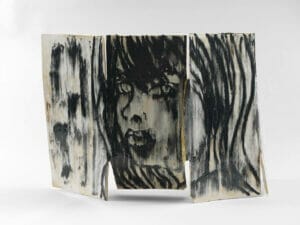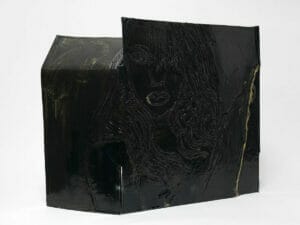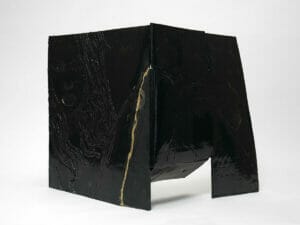The Early Period (1990-2005)
Ghada Amer began experimenting with sculpture soon after graduating from art school in the early 1990s. She created a model (maquette) of her “Screen” in 1992 though she will be able to produce it only in 2004. Similarly, she did an embroidered version of her 9 cube Poufs in 1993 while the painted acrylic version was produced almost 10 years later, in 2002.
The First Turning Point: 2010
Creating Sculpture in Painted Resin
Creating objects as 3D sculptures is an expensive endeavor and as an art student and earlier in her career, Ghada Amer lacked both the financial resources and the technical skills necessary to cultivate that type of artistic medium.
In 2010, His Excellence Sheikh Hasan bin Mohamed bn Ali Al Thani from Qatar gave Ghada Amer the opportunity to innovate, expand her artistic production, and produce 3D non-embroidered sculptures. For the opening of Mathaf: Arab Museum of Modern Art in Doha, Qatar, Ghada Amer was encouraged to try experimental new work and was given the financial resources to succeed.
During this early phase, her sculptures were made mostly in painted resin.
About her sculptures, Ghada Amer states:
“My main thoughts are formal. I wanted to make an empty sculpture and I wanted this sculpture to have an important shadow that would be added or be part of the sculpture itself. I also wanted to make sculptures with lines, like writing in space.”
Starting in 2010, Ghada Amer began building what has been dubbed her “egg-shaped” sculptures, oval shaped objects with flowing crisscrossed lines that produce a play of light and shadows on the wall and floor surrounding them. They invite the viewer to gaze back and forth between the inside and outside of the object and to hypnotically contemplate the space within the sculpture.
The sculpture that Ghada Amer contributed to Mathaf: Arab Museum of Modern Art in Doha (Qatar) is her 100 Words of Love. It is considered her first non-embroidered, chromatic sculpture. It is also the piece that initiated her lifelong love for sculpture.
In this sculpture (like in her contemporaneous 35 Words of Love and the 2012 The Words I Love the Most), Ghada Amer carved some of the unexpectedly large number of vocabulary terms that express “love” in Arabic. Words such as “desire,” “depression,” “passion,” “craze,” “anxiety,” etc. spelled in Arabic form the lines of each of her egg-shaped sculptures. The slight inclination of the objects revokes in the viewer the Earth’s Axis.
The Second Turning Point: 2011-2012
Brass, Stainless Steel, and Bronze
Upon discovering Ghada Amer’s sculpture work and anticipating the potential it held in terms of innovation, Kukje Gallery (Korea) challenged the artist to innovate further by re-creating her resin works in bronze. Kukje Gallery thus became the principal sponsor of Ghada Amer’s earliest bronze sculptures.
Tina Kim (then director of Kukje Gallery) invited the artist to create five metal sculptures and to try building them in different sizes. This is what led to the creation of: Baisers #1, Baisers #2, Heart, Blue Bra Girl, The Words I love the most, all of which produced between 2011-2012. They are the artist’s first experimentations using 3D figures (as opposed to calligraphy) in polished stainless steel, and bronze.
Learning from her experimentations and as she began to master some of the basic skills of sculpture from her work with 35 Words of Love and 100 Words of Love, Ghada became fascinated by the play of light and shadows produced by her empty objects. She decided to focus on this dimension in her next sculptural creations.
With The Words I Love the Most (2012), Ghada Amer carved once again some of the large number of terms that mean “love” in Arabic but this time, all the words are written in reverse, in such a way that they can be read only from the inside of the sculpture while they appear inverted on the outer surface. However, with light, the shadows that the sculpture makes on the wall spell out the Arab words correctly.
The reversal of the words for “love” and their correct spelling on the wall reflects the way Ghada Amer considers love. As she observes: “We do not understand love. So we only see the right side when we are far away.”
Continuing her experimentations with sculpture, Ghada Amer challenged herself to create new 3D metal work of women standing up and looking strong, resolute, rebellious.
She explains: “I wanted to create a sculpture in which women would look defiantly at the public. I thought it was important that they should all have their eyes open and be looking at the viewer. I also wanted the women standing, instead of lying down.”
Though created before the Arab Spring, the title of this work was inspired by a well-known incident that took place in Egypt during the 2011 uprisings. The specific event related the violence to which a veiled female protester was subjected, as she was arrested and dragged by policemen who tore her clothes, showing the blue bra she was wearing. The event was photographed and widely circulated and the woman’s blue bra became the symbol of police violence. That protester became known as “the blue bra girl” in all media coverage.
This timely event inspired Ghada Amer to title her sculpture accordingly, as though to solidly enshrine women resilience for generations to come. She states: “I titled the piece after that incident, as a homage to all those women who stand up for themselves and fight.”
Becoming Independent: Learning to create her own prototypes
Residency at the Greenwich House Pottery, NYC (Aug. 2013 to Feb. 2015, and again in 2016-2017)
The more she worked with metal, the more Ghada Amer realized that she had to learn to create her own prototypes so that she could better control the technical realization of her steel sculptures. Up to then, she had had to delegate that part to specialized workshops and to artisans.
To create her own prototypes meant learning ceramics since the prototypes for steel sculptures are typically made with clay.
And it was at the Greenwich House Pottery in NYC and under the supervision of its director, Adam Welch, that Ghada Amer started her training in ceramics.
Even though Ghada Amer thought that the study of ceramics was going to be a means to an end, she, faithful to her interdisciplinarity and boundless curiosity, quickly fell in love with the means itself. The period spent at the Greenwich House Pottery was therefore extremely rich both for the development of her sculpture practice and for expanding her artistic practice in general.
One of the fundamentals that Ghada Amer was excited to learn and to include in her ceramic work was color and glaze. As an artist and as a painter, she was especially relieved to be able to play and produce brightly-colored ceramic sculptures (color applied to bronze sculptures was, in contrast, much more delicate and did not last permanently especially in outdoor settings).
Going even Further: The Koehler Residency (2017)
Learning Casting and Plating
Ghada Amer’s interest in sculpture was on the rise and the artist was determined to also master the techniques of casting and plating in order to develop her practice. A 2017 Art/Industry Residency at the John Michael Koehler Art Center at Sheboygan, Wisconsin provided her with the timely and fitting opportunity to further her expertise in the workings of sculpture.
For the artist, the residency at Koehler was a period of joyful experimentation and of total artistic freedom. Because she was not (nor did she consider herself) a professional artist of sculpture, she felt freed from the constraints of art (painting) history and she could approach her new medium with openness, greater inventiveness and wonder. During this residency, she also discovered the use of brass, a metal rarely employed in sculpture.
Sculptural Silhouettes: Free Standing or Mounted on the Wall (2021)
While at Koehler and as she was refining her skills working with metal, Ghada Amer developed a series of sculptural silhouettes mounted on the wall or free standing. These sculptures (similar to her earlier ceramic egg shaped sculptures) play with light and shadow, and highlight once more the artist’s interest the role of the gazer and the gazed, the woman and her ineffable identity.
Even though these new cast sculptures depict silhouettes of women from pornography magazines, Ghada Amer likens them to her “friends.” After all, these are the very women she had painted and reproduced for decades in earlier canvases. Despite their anonymity, they had become very much familiar to her, akin to people she knows and cherishes.
From Ceramics to Bronze (2022 - )
The ceramic sculptures that Ghada Amer produced during her residency at Greenwich House Pottery (2013-2015) became artworks in their own right. They also became prototypes for some of the bronze sculptures she has produced since 2022.
Using giant flattened cardboard boxes shaped as screens (like the ones she had used to produce her ceramic box sculptures), Ghada Amer cast the cardboards in bronze. On each freestanding box, Ghada Amer displays prominently and on each side images of hypersexualized women’s bodies.
Women are here on display, created to be viewed on the very object often used to shield their body from view. The bronze screens do not conceal, nor do the drips that stripe down from them (in contrast to the drips in the artist’s paintings that tend to obscure women’s bodies). The exhibition of the women’s bodies is matched here only by the gaze of the viewer who consumes such images.
Courtesy Tina Kim Gallery
